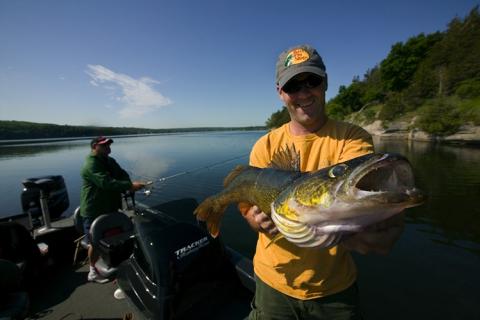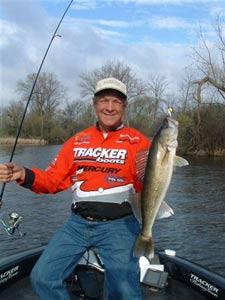
When the Professional Walleye Trail headed south a dozen years ago, it's likely a few eyebrows were raised on logo-capped heads. Destinations like Missouri, Kansas, Kentucky and Arkansas — bass country — seemed a far ways removed from the northern walleye belt of the Great Lakes states and upper Missouri River reservoirs.
|
|
| Daryl Christensen |
But it's not surprising that North America's finest walleye anglers fared well on these distant venues, often revealing populations of fish local anglers were either unaware of or pretty much ignored.
Southern PWT events have showcased excellent walleye fisheries, bringing big time attention to such. And the contestants, well, they've learned that there are both similarities and differences in catching walleyes removed from pine-studded shorelines.
Southern Bound
It takes a spirit of adventure to be a walleye-tournament angler. So blazing trails south of the Mason/Dixon wasn't much of a stretch for most. "I love fishing new waters," said longtime PWT pro Daryl Christensen, of Montello, Wisc. "That's the whole deal for me. You learn so much, because you don't approach the water with any preconceived ideas. "Christensen said the prospect of fishing southern waters, especially during early-in-the-year events, expanded the season. But a period of adjustment was necessary.
"One of things what was obvious to me was how the calendar speeds up down there," said Christensen, winner of the Super Pro event on Missouri's Lake Stockton in 1998. "The lakes don't freeze. So for all of us that grew up fishing ice-out and pre-spawn periods, that mentality had to be adjusted." Richland Center, Wisc.-pro Bill Ortiz was a bit skeptical when he first heard the tour was going south. "We thought, 'What are we doing?'" he said. "But we found out there are some beautiful walleye fisheries there."
Similarities
Ortiz, who has enjoyed success on reservoirs in general, and won the 2005 Berkley/Lowrance Pro-Am on Bull Shoals Lake in Arkansas, feels southern impoundments have much in common with their northern and western counterparts. "I've found that reservoirs are reservoirs," said Ortiz. "They fish pretty much the same. The first step is locating the area of the reservoir they are using, and then fine tuning things from there. The southern reservoirs fish very much the same as the western reservoirs.
"The key to reservoir fishing is to have a ton of spots, because the fish move around so much. Running and gunning is something I feel comfortable doing," he said. "A lot of times some of the places that weren't so good in practice end up being your best spots during the tournament." Ortiz said walleyes move up on the points to feed, and then slide back off. You might not be there when the fish are feeding, and it doesn't pay to camp out there, hoping the fish move shallow. He said you're better off moving to the next stop.
Still, during the 2005 event Ortiz discovered that when shallow flats and points were thick with bait (gizzard shad) he could trigger bites from walleyes by pulling both crankbaits and bouncers/spinners through the baitfish. This would scatter the bait, he said, and help activate the walleyes. It was a pattern he stumbled on to. "On Day one of the tournament I got into much shallower water than I wanted, in 3 to 4 feet," he recalled. "I caught three fish in there, but I bailed out, because I had been catching fish in deep water, and some of them were better fish."
Ortiz's ensuing deep water efforts zeroed out during the balance of the first day of competition, so he returned to the shallows, which is where he tallied up the winning weight.
In reservoir situations, southern reservoirs included, where the need to cover water in search of active walleyes is vital, spinners/bouncer combinations continually prove their utility. When Mike Gofron won the 2004 Mercury/Realtree Pro Am on Bull Shoals, spinners were the winning tactic. The spinner's use has prominently figured in many southern events, just as it has on more traditional walleye waters.
Subtle Differences
Though PWT tournament experiences have proved southern walleyes have a lot in common with their northern cousins, some subtle distinctions have been noted.
"During the early season, in the springtime, southern reservoirs can be tougher to fish," said pro Mike Gofron from Antioch, Ill. "The water is clearer, especially in Bull Shoals. The spots can be fragile. On the Missouri River systems, for instance, when the wind blows, mud lines develop. The shallow fish aren't as spooky. But there's a lot of rock in the southern reservoirs, and wind doesn't seem to cloud up the water."Gofron believes southern walleyes may be more sensitive to cold fronts than northern fish.
"I call them sissy walleyes when it comes to cold fronts," said Gofron. "Northern fish probably become a bit accustomed to drastic weather changes. In the south, severe cold
fronts throw them in more of a tizzy."
Due to this tendency, Gofron believes it's necessary to fish deeper under post cold front conditions. "They are also similar to Great Lakes walleyes in that they are not tolerant of boat pressure," he added. "They don't have to stay on structure. They can move on because there's a ton of structure in there."
Christensen said southern 'eyes tend to be more aggressive toward larger baits, illustrated by the number of fish taken by local bass anglers chucking good-sized crankbaits. He's had good success throwing larger crankbaits on points, a tactic that was significant for him during a third place finish on Lake Cumberland. And it's not surprising that Christensen, one of the tour's most respected jiggers, would include jigging as an effective southern tactic.
"I won the Stockton tournament pitching jigs to the shallows, during a post-spawn bite," he said. "And on Lake Ouachita, I did well in practice pitching jig in the shallows. The pattern didn't hold up during the tournament, though, and I had to switch to spinners. But in general, I think that shallow jig bite holds into May, when the fish move deeper as they follow the shad."
Worth the trip?
The positive experiences enjoyed by the PWT confirm the notion that for northern anglers, it's worth a trip south. And for many of the locals, they are missing out on some fine walleye fishing.
Ortiz said that the first year the tour visited Bull Shoals, an older gentleman pulled up to him and asked what he thought of their "pond." "I replied that I had caught 14 or 15 walleyes that day," he said. "Just then I had a double, a spotted bass and a walleyes. He wanted to know what I was doing. I told him to come to the weigh in on day three and I would show him."
Speaking specifically of Bull Shoals, Ortiz said there are a lot of 4- to 5-pound fish there, and that he's taken them to 7 pounds. Other tournament anglers caught fish in excess of 7 pounds. "The 18-inch size limit protects the smaller fish," said Ortiz. "And when they get big enough to be legal, they are not as easy to catch."
The bottom line, as Christensen pointed out, is that walleyes are still walleyes, and they don't know where they live.
- 3689 views


